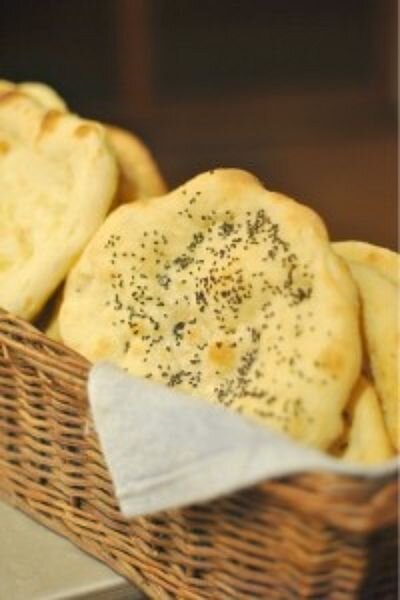Homemade naan
Loading...
Tony and I are on a much-needed vacation this week. Poor grad students that we are, we couldn’t afford much, so we’re at Mom and Dad’s Pennsylvania house for the week doing what we love: cooking, eating, and drinking. We’re also doing a little homework, taking long walks, and reading for pleasure. But mostly, we’re cooking.
Our first night here, we made a simple but incredible sausage and broccoli pasta and enjoyed a long cheese course in front of the fire. The next night (which was much warmer) we grilled steaks and pimeton-coated potato slices and finished with my favorite winter salad: sliced cabbage with homemade balsamic vinaigrette.
Last night, we decided on a long-simmering chicken and potato curry. Since we had the time, we bought a whole chicken and I taught Tony how to cut it down into parts and how to de-skin and de-bone it. We threw the bones into the curry, too, while it cooked to give it more body and flavor.
I won’t make Indian food without making naan. And since the curry already had potatoes in it, we decided to skip rice and just make the flatbreads. As I usually do, I went to our website to look for my recipe. WHAT?! I’ve never posted a recipe for naan? I could swear I had! I made a metal note to remedy that … ASAP.
After good old rustic loaves, naan is probably my favorite bread to make. And it’s one of the only breads that I don’t pull out my food processor for. In order to achieve the perfectly soft, pillowy texture I love so much, I take a little extra time and develop a little extra arm muscle in order to stir it by hand. I love that the recipe I’ve been using for years requires – in a quirky and unexplained way – that the dough must be stirred in the same direction for the entire time. I am not sure why this is necessary, but I always do it.
As the curry simmered and the naan dough rose, we went out and played some Frisbee and Tony taught me how to throw and catch a baseball … properly. Barring one minor incident where I missed the ball and caught it with me chest, it went pretty well! (I’ve got a sweet bruise to show for myself, too.) We arranged heavenly cheese course part two, and sat down to watch the funny-yet-tragic documentary "King Corn."
Mid-movie, the dough was ready and the curried chicken was fall-apart tender. So we pressed pause, quickly shaped and baked the dough, and were back in front of our movie in under 20 minutes. Did I mention naan only takes about 7 minutes in the oven?
So, without further ado, here is my second favorite bread, the constant companion of my Indian meals, and my breakfast for days after those meals. The softest, most tender, and delicious naan I’ve ever made. My old friend.
Homemade naan
Makes 10 naan breads
This recipe is adapted from Jeffrey Alford and Naomi Duguid. They make their naan on baking tiles using a pizza peel to move them on and off. This is great if you have them, but you can also just use baking sheets. If you can let it rise 8 hours, definitely do. But if you’re pressed for time, place the dough in a warm spot, and it’ll be ready after 4 to 6.
2 cups lukewarm water, about 100 degrees F
1 teaspoon active dry yeast
1 cup milk
6 cups all-purpose flour, more or less as needed
4 teaspoons Kosher salt
3 to 4 tablespoons unsalted butter, melted
Oil for the bowl
Cornmeal for dusting
Nigella seeds, sesame seeds, or minced garlic for topping (optional)
Make the dough: In a liquid measure, stir together 1/2 cup of the warm water and the yeast. Heat the milk in the microwave or in small saucepan to lukewarm, about 100 degrees F. Pour the milk and remaining 1-1/2 cups warm water into a large bowl. Stir in the yeast mixture. Using a spatula or wooden spoon, gently stir in about 2 cups of flour until smooth, stirring always in the same direction. Stir in the salt and continue stirring in flour, 1/2 cup at a time, until the dough is too stiff to stir but is still soft. Turn out the dough onto a lightly floured surface. Wash, dry, and lightly oil the bowl. Knead the dough until it’s smooth, 2 to 3 minutes, incorporating only enough flour (by keeping the work surface dusted) to prevent the dough from sticking; the dough should be quite soft and not tight.
Put the dough in the bowl, cover with plastic, and let it rise in a cool place for 8 hours or overnight.
Shape and bake: If using tiles or a baking stone, set your oven rack in the upper-middle position, place baking stone or tiles on the rack (making sure there is a gap around the border for heat to circulate), and heat the oven to 500 degrees F about an hour before you are ready to bake to allow the stones to get hot. If using baking sheets, place your oven racks in upper- and lower-middle positions, and heat the oven to 500 degrees F.
Pull the dough away from the sides of the bowl and transfer it to a lightly floured surface. Cut the dough in half, putting half of it back in the bowl (covered) while you work with the first half. Cut the dough half into five equal pieces. Dust your peel or baking sheets lightly with cornmeal.
Working one at a time, place a piece of dough on your work surface and gently push it out with your fingertips to rough 9×7-inch oval; try stretching it by draping it over the back of your hands and pulling gently. Place on peel or sheet; repeat with a second piece of dough. Brush each one with a little melted butter and sprinkle with seeds or minced garlic, if using.
If baking on stones, transfer the flatbreads to the oven and bake until their rippled tops have light golden spots and the bottoms are golden, 5 to 7 minutes. Remove them with the peel, transfer to a rack to cool for about 5 minutes. If using baking sheets, prepare a second sheet and bake one sheet on the upper and lower racks, switching half way through.
Wrap them in a cotton cloth to keep them soft and warm. Repeat the shaping and baking process with the remaining pieces of dough.
Sharon Anderson blogs with her mother and sister at Three Many Cooks.
To comment on the original post, click here.
To receive Monitor recipes weekly sign-up here!
--------------------------------------------------------------
The Christian Science Monitor has assembled a diverse group of food bloggers. Our guest bloggers are not employed or directed by The Monitor and the views expressed are the bloggers' own and they are responsible for the content of their blogs and their recipes. All readers are free to make ingredient substitutions to satisfy their dietary preferences, including not using wine (or substituting cooking wine) when a recipe calls for it. To contact us about a blogger, click here.






